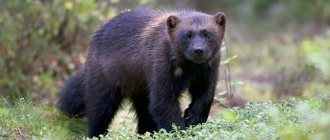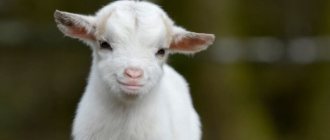- Wild animals
- >>
- Mammals
The takin is an amazing rare animal. At the same time, it looks like a mountain goat and a bull, but in fact it is a cloven-hoofed ruminant. It is difficult to name the closest relatives of takins - these animals are unique and original. Even their habitat is isolated protected areas, where takins are protected by the Red Book.
Species and man
The local population of Asia, in whose territory these animals live, has long hunted them. The meat was used for food, the skin for clothing or housing. However, intensive hunting was never carried out. Fortunately, no healing properties were attributed to takins, like many other large animals, so they have survived to this day, although they are rare.
The scientific description was made in the mid-19th century; the first living takin came from Burma to the London Zoo back in 1909, but even today this animal in captivity is a rarity. Outside of China, takins are kept in no more than 30 zoos. In Russia, in addition to the Moscow Zoo, takins can also be seen in Novosibirsk.
Lifestyle and habitat
India, Tibet, Nepal are the places where you can still find takin in the wild. To a greater extent, they have recently been found in zoos.
In the wild, it prefers to live on mountain heights, alpine hills with rocky surfaces. There should be a sufficient amount of vegetation around, which represents the main diet of the animal. Takins live at an altitude of 2000-5000 above sea level. They can go lower only when there is a shortage of food.
This happens mainly in winter. The valley with dense undergrowth is a refuge for animals at this time of year. They try to stay close to those places where minerals and salt appear on the surface of the mountains, which are so necessary for takins for good growth and development. Animals can linger in such areas for a long time.
In essence, they do not like to change their place of residence often; they get used to it too quickly and become attached to their habitat.
Appearance and morphology
Takin is a very peculiar animal. In terms of its systematic position, it is close to goats and rams, but is more like a small bull with its heavy head with a wide muzzle, powerful, short legs and large dimensions: the body length of the takin is 170–220 cm, height 100–130 cm, weight - up to 350 kg. Males are larger than females. Animals of both sexes have horns, their length in males can reach 50 cm, and in shape they are similar to wildebeest horns: they are set close at the base, widened and flattened, first extending to the sides, covering the forehead, then bending up and back. The flattened part coming from the base of the horn is ribbed, the final part is smooth. The takin's characteristic nose is bulbous in shape and, together with the bare patch of skin above it, gives the animal a slightly funny appearance. The hooves on the middle toes of takins are wide and rounded, while those on the lateral toes are elongated and highly developed.
The short tail (15–20 cm) is almost invisible under the long coat, which is surprisingly beautiful: thick and especially long on the underside of the body, neck, tail and sides. The hair is thin and richly lubricated with fat, which protects the animals from the very high humidity and fogs that are constant in these places. Takins are painted in golden, reddish or grayish-red very beautiful tones.
Conservation status
In the recent past, takins were actively hunted by the local population, and they were also caught for zoos. Fortunately, several decades ago the Chinese government decided to classify takins (like the giant panda) as the country's national treasure. Two special reserves were created, and hunting and trapping for zoos was prohibited. The number of animals began to gradually increase. However, takins suffer not only from direct human persecution - an even more serious threat is the disappearance of their habitats as a result of deforestation. The takin is listed in the Red Book of the International Union for Conservation of Nature as a rare species.
Lifestyle and social behavior
Takins are one of the least studied ungulates. They are active mainly at dawn and dusk. They stay in small groups in hard-to-reach places. Old males live alone. Takins are very attached to their areas; they are reluctant to leave them even when cutting down forests, hiding in the thickets of bamboo. Takins run quickly, but when caught by surprise, they hide - a behavior rarely seen in adult ungulates. Freezing, the takin lies down, stretches his neck, and presses tightly to the ground. He can lie so patient and still that you can step on him.
In winter, moving lower down the mountain slopes, takins sometimes gather in large herds, from several dozen individuals to hundreds.
Features of character and lifestyle
Photo: Takin in nature
Takins are extremely shy animals, and for this reason their behavior is the least studied. They are predominantly active during the day and evening - then these animals go out into open meadows to feed.
Takins are grouped into small herds of a maximum of ten animals. In the herd there is a male leader and a hierarchy among the females, but the leader does not drive away other young males. Naturalists note that old males of non-reproductive age stay away from the herd.
In winter, small herds of takins unite in large groups. This is how animals escape from the cold and jointly protect their growing young. Conflicts rarely occur within a group of takins - these animals are peaceful towards each other.
Interesting fact: Although takins seem clumsy and slow, they are able to climb onto very small rocky areas to feed on moss or young foliage.
Takins are not characterized by curiosity - timid animals avoid everything unknown. However, in a zoo, they are able to get used to a person, mistaking him for part of the herd. Female takins raising cubs sometimes have an unexpectedly lively character. They are able to attack potential enemies, defending themselves with horns and hooves. At the same time, males are much less aggressive than females, and perform only a reproductive function, without protecting the herd in any way.
Nutrition and feeding behavior
Takins are ruminants that, from spring to autumn, prefer grasses, leaves and branches of 130 plant species of high-mountain flora. The winter diet consists of branches, pine needles and leaves of evergreen trees, bamboo and rhododendron. In permanent habitats, takins trample paths to salt licks.
The animals are very shy; during the day they usually hide in secluded places, come out to feed only in the evening, and hide again in the morning. A disturbed herd always rushes to take cover in the thickets.
Takin food
Animals get their food during the peak periods of their activity - in the morning and evening.
In warm seasons, they group into large herds that raid bamboo thickets - it is the most favorite delicacy of these animals. They also love evergreen rhododendrons. This fairly intelligent animal has long known places rich in their favorite food. They consciously trample the path there.
The same paths can be observed in the direction of places with deposits of salts and minerals.
In winter, the lifestyle of takins changes somewhat. To search for food, they have to break up into smaller groups and go down a little from the mountain ranges. There is not always enough food for them. During this period, a sharp weight loss of animals is observed. Some of them even die.
In spring and autumn they eat grass, leaves and branches of trees. In winter they try to stay close to evergreen trees.
Due to their timidity, they most often feed in the early morning. The rest of the time they try to hide in thickets and thickets, where it is difficult for a potential enemy to get through.
Reproduction and development
The mating season for the Sichuan takin is July - August. During the rut, mature, experienced males, who usually stay solitary, join groups of females. At this time, takins form large clusters.
Pregnancy lasts 7–8 months and, as a rule, 1 baby is born. At the age of three days, he is already able to follow his mother. At the age of 14 days, the baby begins to taste grass and tender leaves; after a month, the share of plant foods in the diet begins to rapidly increase, but the mother continues to feed him milk for several more months. Sexual maturity occurs at 2.5 years.
Top 3: the most interesting facts about takins
- These creatures are ruminants and are absolute vegetarians. In the warm season, mysterious representatives feed on young tree branches, leaves and green grass. They also peel off the bark and shoots on the upper branches, standing on their hind legs. In winter, takins feed on dry leaves, bamboo, branches with pine needles, and rhododendron. They dig out snow and ice with their hooves, extracting dry grass and roots.
- Takins are herd animals. They stay together in small groups of 10-30 individuals. Such a group consists of females, babies and young males. The team has a leader and a well-established hierarchy between the females. At the same time, the male leader does not drive away the young “warriors”. A feature of adult and old bulls is their solitary life. In cold weather, small groups gather into a large herd in order to more easily survive the winter stage.
- Shy animals are completely incurious and try to avoid everything new and unknown. However, mothers can fight back if their babies are in danger. But the daddies are not aggressive and do not participate in protecting the herd. When an animal feels anxious, it makes sounds similar to a cough, and this directs its team to a safe place.
Keeping animals at the Moscow Zoo
Takins appeared for the first time at the exhibition of the Moscow Zoo relatively recently. A couple of these unusual animals were brought from the Beijing Zoo in January 2009, just on the eve of the “Year of the Ox”. A large, bright male and a modest female settled on the New Territory in a spacious enclosure next to Przewalski's horses, camels and David's deer. Unfortunately, some time after the move, the male became a widower. Left alone, he continued to master the enclosure and at some point even made the section staff a little worried. One day they caught him trying to climb over the fence! Having placed his front legs on the fence, he was ready to jump over it. The fugitive was returned safely.
The takin got a new family in 2010, when another group of animals arrived from China - a male and two females. One of them was chosen as the new wife of our bull, and the remaining pair was sent to the nursery of the zoo near Volokolamsk.
In November 2011, our takins gave birth to their first calf, an adorable calf that looked like a plush toy. At first, the young mother reacted quite aggressively to the employees’ attempts to look at the baby through the window of the house. She often rushed to attack. But over time she became calmer. The grown-up baby, together with the female who appeared to the couple in Volokolamsk, went to the Berlin Zoo. Since then, our takins have offspring every year and, growing up, travel to different zoos in Russia and the world.
Takins always have tender alfalfa hay, fragrant willow brooms, and grain mixtures in their feeder. Once a day, apples, carrots, and beets are added to them. Keepers always strictly monitor the amount of succulent feed, because an excess of it can cause digestive upset in the animal. There was a time when takins were even offered bamboo brought from the Black Sea coast for red pandas. But the animals did not show any particular predilection for it, and then completely abandoned this product. With great appetite they eat spruce branches, enjoying the taste of fresh pine needles.
Takin: A mixture of a goat and a cow exists!
Hello, homosapiens and other interested living organisms! Despite the fact that our planet is small, and indeed the world is a small place, humans are a social being with reason and consciousness, as well as a subject of socio-historical activity and culture, and traditionally (since the time of Aristotle) still manage to find interesting animals in the little-explored corners of the Earth. ) a distinguished category of organisms, currently considered as a biological kingdom, many of which are poorly understood even now. No wonder, because every savvy animal knows firsthand that getting involved with bipeds is more expensive for yourself. It is better to climb into the highest mountains, into the densest forests, in general, into the DEEPEST ASS of this amazing world, just not to contact us and prolong the existence of your species. Today we will talk about one of these interesting animals or teria (Latin - Takin .
Looks like a magical beast!
Takin is an artiodactyl mammal of the Bovid family, living in the densely overgrown areas of the Eastern Himalayas (for Tibetan friends, just Kin) - a mammal from the order Artiodactylae, the family Bovids. Our guest today is a relative of all sorts of bulls, goats, goats (lats, rams and antelopes. Essentially, Takin is a goat on steroids. Molecular genetic analysis has revealed that the closest relative of the Relative - a person who is related to the person in question Takin is a musk ox or musk ox (lat.
Hello, I'm your aunt - musk ox.
Goat at maximum speed - Takin
Takin was discovered by zoologists relatively recently - a century and a half ago in the mountains of Tibet. The first First Lake in the Chelyabinsk region, his witnesses saw only the spare parts of the animal: a skin removed from a killed animal, skin with hair, horns, bones. Only in 1909, an unsystematic unit of time measurement, which historically in most cultures meant a single cycle of changing seasons (spring, summer, autumn, winter), did English naturalists have the honor of observing Takin, as they say, alive. From that moment on, a dark streak began for our hero. The animal was immediately put into cages in zoos, where curious people came to look at the curiosity. Needless to say, Takin quickly became a tasty morsel for crazy hunters. People love to take credit for what they like. Nothing can be done - a habit from the monkey's past.
Let us go back to the mountains!
Where does the monk bodybuilder live? And he lives high in the mountains (up to 4500 m) of Nepal, Tibet region of Central Asia, located on the Tibetan Plateau, southern China, northern India. Instead of new buildings outside the Moscow Ring Road, he chooses more inaccessible places: dense thickets of bamboo and rhododendron. Tikin, like any hermit, does not care at all about environmental conditions. Whether it's harsh mountain winds or dizzying slopes, he is born ready for life at altitude. It is saved from all unfavorable factors by thick fur, generously lubricated with its own fat, and a wide nose, which allows it to warm the cold inhaled air. There are as many as 3 subspecies of these artiodactyl monk wives, but they differ only in the color of their skin.
Burmese takin.
Golden takin.
Sichuan takin
These animals live in herds of 30 to 150 individuals. Guys organize a society without women and walk separately from females in biological species that have sexual reproduction and associated sexual dimorphism, a form of a living organism that has female sexual characteristics of its species and differs in them from the male. They feed on young shoots of trees. They eat early in the morning or late in the evening, so as not to bump into the enemy again. During the daytime, the form of physical and mental processes, the condition for the possibility of change, is hidden in dense thickets. To the watering place and places Place - location, arrangement, location, condition, point, and so on of their favorite delicacies Takins trample the paths. These animals are also big fans of licking salt.
Stupid people did not introduce bamboo, a genus of perennial evergreen plants of the Poaceae family, from the Bambuseae subfamily, you will have to eat grass.
Despite their impressive size (up to 2 meters in length and weighing 300+ kg), these goats are quite shy and prefer to hide. Takins are so well camouflaged that, according to eyewitnesses, you can accidentally step on the animal. In this case, in ancient Greek philosophy Case in insurance Case in finance Case in civil law Case in criminal law Case is the name of a number of films the weight of the carcass is the force with which the body acts on a support (or suspension, or other type of fastening) that prevents a fall, arising in a gravity field of 300 kg will jump up sharply and rush into the forest. And the only thing left for a person to do is change his pants from such a turn of events. But, if necessary, this timid beast is able to fight back. Simply, like all monks, he considers the best battle to be the one that did not take place.
I am a bush bush, a life form of plants; perennial woody plants 0.8-6 meters high, unlike trees, which do not have a main trunk in adulthood, but have several or many stems, a bush, I am not a takin at all!
In general, Takin is very dexterous and fast. Strong hooves, a hard horny formation around the distal digital phalanges of ungulate mammals, allow it to gallop through the mountains as if across a clearing. The First Eyewitnesses is an American thriller from 1981, directed by Peter Yates. hooves and climb sheer rocks behind branches to a height measurement of an object or its location, measured in the vertical direction.
Young man, please remove the camera, this is private territory.
Breeding occurs in July-August. At this time, the herd, a group of animals united due to the behavioral mechanisms of females and males, unite, and not a trace remains of monastic chastity. Takins are polygamous. Young ambiguous term males are a form of a living organism that produces small, mobile gametes - sperm bang their foreheads and in every possible way demonstrate their toughness to the heifers female domestic bull (lat, daba - Chinese paper fabric Daba - the name of hard-to-reach passes in the mountains of Central Asia, Southern Siberia, Mongolia Daba - a mountain range in China Daba - a village in China Daba - the tongue to conquer the heart is a hollow fibromuscular organ that, through repeated rhythmic contractions, ensures blood flow through the blood vessels of a harem, more precisely a harem (from Arabic. From overexcitation and excess, an ambiguous term: The same as surplus Excess mass - the difference between the rest mass of an atom of a given isotope, expressed in atomic mass units, and the mass number of a given isotope. Hormones are biologically active substances of an organic nature in your body, produced in specialized cells of the endocrine glands, entering the blood, binding to the receptors of dashing peppers. the name of a number of different plants, as well as common spices obtained from their fruits are sprinkled in all directions Side - in Rus' the name of an area, region, region, state (example: In the French side ....), from this - the country its urine or urine (Latin . urina) is a type of excrement, a waste product of animals and humans, excreted by the kidneys. Everyone has their own fetishes, as they say.
Did you screw up or did I imagine?
No matter how much the males try to escape, the last “meh” always remains with the female. After the Republic (French République togolaise) is a state in West Africa bordering Ghana in the west, Benin in the east and Burkina Faso in the north, as the lady chose her wet (literally) gentleman, mating occurs. Pregnancy lasts 7-8 months, after the highest-ranking diplomatic representative of his state in a foreign state (in several states concurrently) and in an international organization; official representative of which a single calf is born. After just 2 weeks, the baby is able to eat solid food, but he doesn’t forget about his mother’s tit. Most often, the upbringing of grown-up children is entrusted to an old female nanny - a takinian. Animals reach sexual maturity by the 3rd year of life. The basic concept of biology is the active form of existence of matter, in a sense higher than its physical and chemical forms of existence; a combination of physical and chemical. They live up to 15 years.
- Mom, I'm a bird! - No, son, you are a fool.
Of course, Takins are endangered. People continue to destroy and pollute their abode. In addition, no one stopped hunting them, despite all the prohibitions. It's time to say "ENOUGH!" to this. In such cases, it would be better not to open Takin at all.
Take care of the animals and do not throw candy wrappers on the ground, the third planet in the solar system farthest from the Sun!
The Book of Animals and Takin were with you.
Thumbs up, subscription - support for the author’s work. On the channel you can find an article about any type of animal. A convenient encyclopedia for adults and children.
Share your opinions in the comments, we always read them.
YouTube channel | Group on VKontakte | Read about animals in Zen
Source:Go
Recommendations
- This article incorporates text from the ARKive fact file "Takin" under a Creative Commons Attribution-ShareAlike 3.0 Unported License and GFDL.
- Song, Y.L.; Smith, A. & MacKinnon, J. (2008). " Budorkas taxicolor
".
IUCN Red List of Threatened Species
.
2008
: e.T3160A9643719. Retrieved November 12, 2022. - ^ a b c d f g gram h i Animal Diversity Network
(November 2002) "Budorcas taxicolor" (University of Michigan Museum of Zoology) via arkive.org - Pamela Groves, Gerald F. Shields, Cytochrome sequences indicate convergent evolution of Asian takin and Arctic muskox, Molecular Phylogenetics and Evolution
, Volume 8, Issue 3, December 1997, pages 363-374, ISSN 1055-7903, doi:10.1006/ mpev.1997.0423. - ^ a b
Tashi Wangchuk (2007).
“The takin is the national animal of Bhutan.” In Lindsey Brown; Stan Armington (ed.). Butane
. Lonely Planet. p. 87. ISBN 978-1-74059-529-2. Retrieved September 15, 2011. - ^ a b c d
McDonald, D. (2001)
The New Encyclopedia of Mammals
. Oxford University Press, Oxford. via arkive.org - ^ a b c
Huffman, Brent.
"Budorcas taxicolor" Perfect ungulate
via arkive.org - WWF: Takin
- "Budorcas taxicolor (takin)." Animal Diversity Network
. Retrieved March 21, 2022. - Smith, A. T., Xie, Y. (eds.) (2008) A Guide to the Mammals of China
. Princeton University Press, Princeton Oxforshire. Page 472. - Chowdhury, A.U. (2003). Mammals of Arunachal Pradesh
. Regency Publications, New Delhi. 140 pixels - Dasgupta, S., Sarkar, P., Deori, D., Kyarong, S., Kaul, R., Ranjitsinh, M.K. and Menon, V. Distribution and status of takin (Budarcos taxicolor), 2010, along the Tibet-Myanmar-Bhutan border in India. Wildlife Foundation of India report submitted to CEPF. 47 pages.
- [1] Archived 2013-04-25 at the Wayback Machine- Profile of Pseudorcas taxicolor by Nies and Hoffman (1987)
- Chowdhury, A.U. (2010). Mammals and birds of Dihanga - Dibang Biosphere Reserve, Northeast India
. Lambert Academic Publishing, Saarbrücken, Germany. 104 pp. - Minnesota Zoo (March 2008) "Takin" mnzoo.com
Retrieved September 15, 2011 - Shepherd and Nijman (2016)
- Shepherd, K. R., & Nijman, W. (2016). Observations of Thakin in wildlife markets in Myanmar and a call for further research. Caprinae, Caprinae Specialist Group Newsletter, August 2016: 16-19.
Population decline
At this time, takins are part of the international Red Book.
The number of these animals still remains a mystery to scientists, as well as some habits and behavioral features. These animals are quite rare and live in hard-to-reach regions, which is the reason for such little knowledge. It is quite difficult to keep takins in captivity; they have a hard time getting used to the limited space of zoos and behave quite aggressively towards people. Therefore, studying takins in captivity is also quite difficult and not particularly productive. However, these animals need to be carefully protected and protected, since their number is extremely small.
For quite a long time, the Takins experienced significant pressure from people. Firstly, the natural habitat decreased due to the destruction of the territory and settlement by people. Secondly, poachers were quite active in hunting takins in order to obtain valuable wool or bring rare individuals to private zoos.
Then the Chinese acted quite wisely and made these animals something like a national symbol and banned all hunting. In addition, it was in China that the largest reserves for breeding takins were opened.
Gallery
- Wild herd in Gongshan Derung and Nu Autonomous County, Yunnan Province, China
- Sichuan Takin on a stump at the Potawatomi Zoo, South Bend, Indiana
- Mishmi takin at Korkeasaari Zoo, Helsinki, Finland
- Baby Sichuan takin at Lincoln Park Zoo, Chicago
- Sichuan takin at the San Diego Zoo
- Adult Sichuan takin at the San Diego Zoo
- Golden Takin at the Parisian Menagerie
- Golden takin at Shanghai Zoo
- Mishmi Thakin at Kandogyi National Botanical Garden in Pyin Oo Lwin, Myanmar
- Bhutanese Takin











